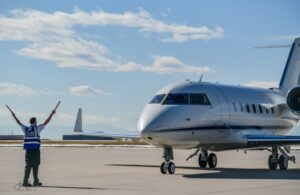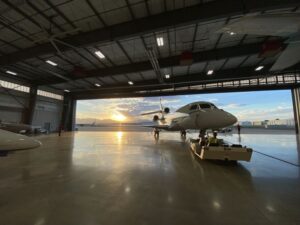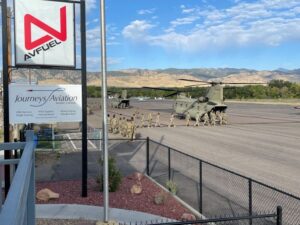Known as the Centennial State for becoming America’s 38th state 100 years after the signing of the Declaration of Independence, Colorado is warm, welcoming, and colorful.
Located at the end of the great plains and the beginning of the Rocky Mountains, Colorado’s rugged and wildly varied landscapes include majestic peaks and forests, high plains, mesas, canyons, plateaus, rivers, and desert lands. Uniquely, nearly 90% of the state’s 5.8 million residents live east of the Rocky Mountains in only a sliver of Colorado’s 104,185 square miles of land area. The result is a population of more than 5 million people living along about 10,000 square miles of mountain frontage called the Front Range.
Colorado is home to 66 public-use airports that serve a varied yet often interconnected conglomeration of interests. As the nation’s second-largest aerospace economy, the Front Range is a well-established full-spectrum aerospace ecosystem comprised of numerous military facilities and a literal who’s-who of the worldwide aviation and spacecraft technology industries. Likewise, the picturesque slopes of the Rockies offer world-class skiing, hunting, fishing, river running, and climbing, long making Colorado a must for thrill seekers and recreational tourists from around the world. The state capital and virtual epicenter of all that is Colorado, Denver is the 19th most populated city in the United States and home to nearly 3 million people in 2024. Having just completed a growth period of more than 10 years, the cost of housing in Colorado has now caught up with the quality of life causing the population explosion to finally slow down.
In the business of aviation, though time is money and choices are many, the competition among Fixed-Base Operators (FBO) in Colorado is not quite as fierce as one might expect.
As these diverse operators show, there are a lot of ways to make a living in aviation.
Focusing on growth

Rheal Gagnon is the general manager of Modern Aviation Denver, which operates at KAPA-Centennial Airport about five miles southeast of Denver. He’s been at the helm since early 2024.
“Our focus is expansion. Denver has experienced tremendous growth. Many corporate entities are moving here,” begins Gagnon. “We are seeing demand for hangar space and office facilities at a high-water level. Through a series of acquisitions in 2024, we now hold about 125,000 square feet of hangar space and 130,000 square feet of office space on the south end of KAPA.”
KAPA is one of the handful of private airports surrounding metro Denver. Each offers distinct locational advantages depending on why people are flying and where they are going.
“Our tenants include private flight departments, aircraft management and charter companies, aviation maintenance services, and even a company specializing in mental health for aviation professionals,” says Gagnon of tenant diversity. “Since the pandemic, more people are appreciating the advantages of private travel for business or pleasure. Flexibility, safety, time-savings and convenience make the private aircraft option preferable.”
To stay competitive, Modern Aviation aims to streamline operations and decrease environmental impact wherever they can.
“As we look toward the future, we want to electrify the ground fleet. We envision all electric fuel trucks, tugs, and other equipment,” says Gagnon. He also stresses the importance of investing in the workforce. Finding the skilled and willing labor needed to shuttle aircraft and resources around KAPA remains a concern for aviation employers of many sorts. “Labor is and will continue to be a challenge. Hiring, training, and retaining qualified line service operators is a passion of mine. The people who tow and fuel aircraft are where the rubber hits the road. So, I invest heavily in assuring their qualifications. What people might not appreciate is that this is a skilled trade that can be taken to any airport in the world to make a decent living.”
As for what’s next in Colorado, Modern Aviation is intent on growth. “We are building. We just completed a 50,000 square foot hangar to help keep our facilities and pricing accessible to as many operators as possible,” says Gagnon. “Our objective is making our operation as safe and customer friendly as we can while striving to perform better in every way.”
Roughly 19 miles northwest of Denver’s city center, Greg Garghill leads Sheltair Aviation’s FBO at Rocky Mountain Metropolitan Airport (KBJC) in Broomfield. Like Gagnon, Garghill came to aviation through line services and worked his way up. As general manager for the Broomfield operation, Garghill is a jack-of-all-trades who enjoys the thrill of getting it done.
“No two days are the same,” he says. “My daily routine involves moving and fueling airplanes, training staff, and managing finances, logistics, fuel contracts, and client conversations. In my time here, Sheltair has grown from a lend-lease operation to a full-blown campus of five hangars.”
Relative to Broomfield’s location mid-way between Denver and Boulder, KBJC offers direct proximity to Colorado’s aerospace industry, the University of Colorado in Boulder, and the world’s most famous live music amphitheater, Red Rocks.
“The biggest driver for travel through Broomfield is the location. We are 15 minutes from Boulder, 25 minutes to Denver, and an hour closer to the mountains than Denver International Airport. Our passengers include aerospace executives, people associated with the University of Colorado, high net worth concertgoers, and outdoor enthusiasts of all sorts.”
With only one other FBO at KBJC Sheltair has found ways to fill in vital services at the airport to increase the operation’s revenue stream.

“We are the only FBO in the Sheltair network to provide deicing services, which makes our location unique,” says Garghill. “We also recently signed a lease agreement with Elevate, a certified Maintenance, Repair, and Overhaul (MRO) aircraft services provider. Having a dedicated MRO on the airport opens opportunities for hop-on charter jet services in the future.”
Though business aviation in Colorado isn’t strictly seasonal, it does follow market fluctuations in the broader economy.
“Covid happened and private aviation came to almost a dead stop. When things resumed, companies with flight departments started traveling privately. Eventually, we started seeing record-setting years for general and business aviation in metro Denver,” says Garghill.
“Now, things have tapered off. There are more aircraft for sale and slightly less private travel.”
To maintain the momentum Sheltair has been building at KBJC, Garghill has turned to surrounding community interests to increase awareness and engagement.
“Filling out our hangar space is challenging. To supplement that when we don’t have long-term tenants, we use our hangars as community event space,” says Garghill. “We hosted a concert attended by more than 800 people with old war planes staged in the hangar and hot air balloons on the ramp. We are also hosting a Girls in Aviation Day to share the love of flight with local young women.”
At the Boulder Municipal, Journeys Aviation sees the business of flight from a few different perspectives. Owner and operator Andrew McKenna is a lifelong aviator. He was engaged in an aircraft rehabilitation project at KBDU when the opportunity to take over an FBO and flight school arose in 2018.
“Journeys Aviation manages the airport’s fuel farm on behalf of the City of Boulder, selling Jet A and avgas aviation fuel. We also provide aircraft maintenance services and manage the ramp for monthly tie-downs and overnight aircraft based here,” says McKenna. “Journeys operates a flight school, so we are also training the next generation of pilots. We rent planes to certified pilots and students, provide flight instructors, sell them fuel, and maintain the aircraft. It all adds up.”
KBDU averages between 55,000 and 60,000 operations a year, an admittedly small figure compared to the volume in either Broomfield or Centennial.
Whereas that may seem a disadvantage, for McKenna, it simply opens other possibilities.

“We also have an extensive glider program here. We operate six training gliders and three tow planes to provide both flight instruction and scenic rides,” he shares. “Some of the other business interests at the airport include a company that monitors airborne pollutants and one that provides data-enhanced airborne intelligence to law enforcement and military activities.”
For McKenna and his counterparts at airports across Colorado, the aviation business remains as dynamic as the people in it. “Private aviation is thriving right now. The demand for pilots will continue and the opportunities to have a legitimate career in aviation are broader than ever. We need all of Colorado’s airports, big and small, to function as part of a statewide transportation system.”





